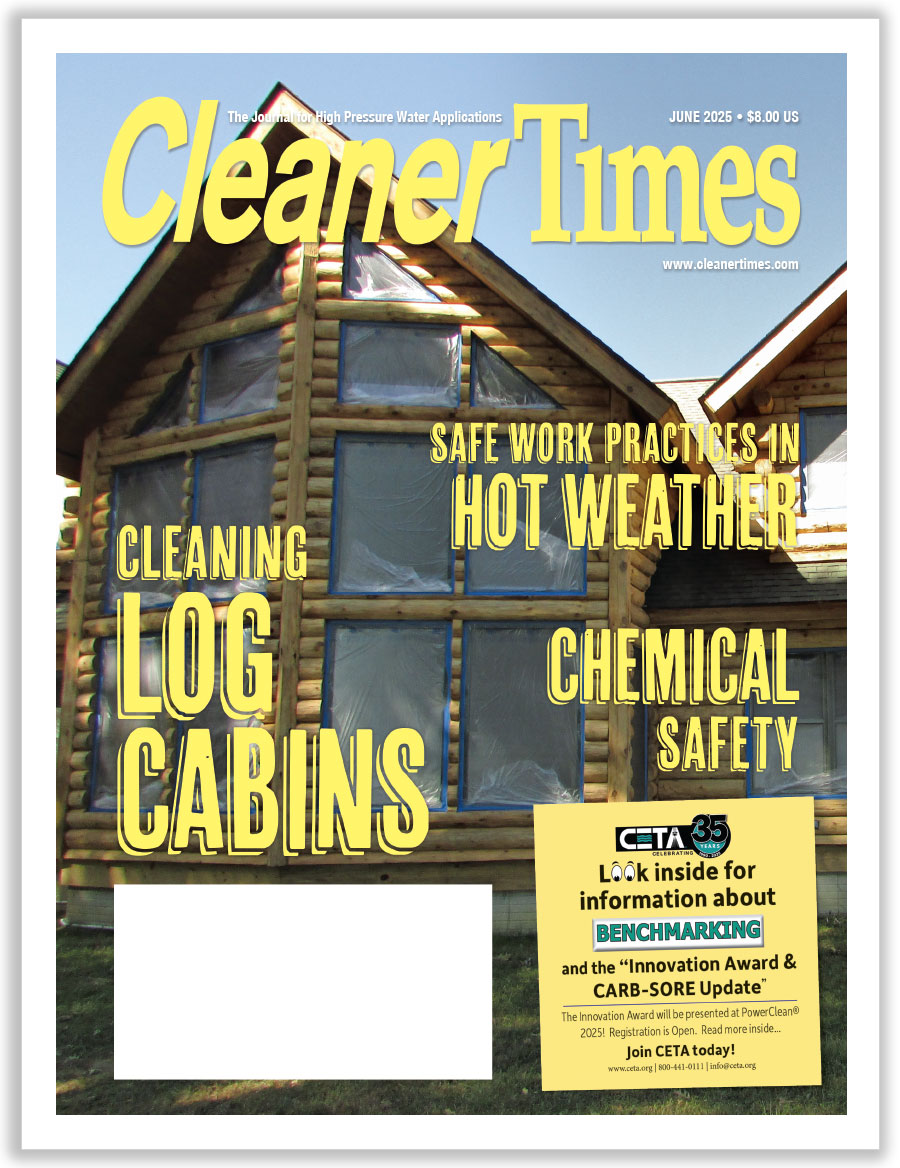
Financial
The Real Cost of Borrowing
By Mark E. Battersby / Published March 2019

Small business lending has taken a significant blow over the past few years. Lower interest rates have translated into lenders being more selective. Fortunately, with many larger businesses reducing their borrowing needs after the initial buying spree that resulted from the tax write-offs generated by the Tax Cuts and Jobs Act (TCJA), there is increased attention to small business lending.
Still to be answered, however, is the all-important question of what it actually costs to fund the operation or the expansion of the pressure cleaning business.
The High Cost of Money
Although often overlooked, two factors have an impact on how much a business loan will cost: the interest rate being charged and the fees required before, during, and after the loan process. They combine to create the annual percentage rate (APR), which is the cost of the loan every year a balance remains.
It is the type of loan needed by the pressure cleaning business that will directly affect the interest rate being charged. However, all-too-often the interest rate stated by lenders will not reflect the true cost of a loan. The loan agreement may require borrowers to maintain compensating balances and pay a number of fees. Among the most common fees are the following:
- Packaging Fee: When applying for a loan, borrowers are usually required to provide a lot of information about the pressure washing business, its finances, etc., all of which generally need to be backed by a great deal of documentation. Whenever assistance is received from a third- party or even from the lender in completing the loan application, the applying pressure cleaning business may be charged a fee for help in assembling the required documentation.
- Processing/Application Fee: A credit check of both the owner and the pressure cleaning business as well as perhaps a personal background check are frequently required. All of this information is gathered and processed by lenders to ensure the application package has everything needed to analyze the probability of timely repayment. The processing fee compensates the lender for the time, work, and expertise required to complete this analysis.
- Underwriting Fees: Once a loan application package has been completed, it normally goes to the lender’s underwriting department where it is studied to verify all information provided is true. The lender also assesses the risk it would be taking by approving or denying the application.
- Closing Costs: Closing costs are usually associated with mortgage loans and can include—but are not always limited to—expenses such as attorney fees, title searches, realtor fees, etc. If a loan includes a real estate transaction, the lender will certainly incur closing costs that may, or may not, be absorbed by the lender or the seller in order to encourage the sale.
- Maintenance or Servicing Fees: These are fees the lender may charge on an ongoing basis (monthly, quarterly) to service a loan, i.e., handling payments, sending out notices, responding to inquiries, etc.
And there is a fee unique to U.S. Small Business Administration programs:
- SBA Guaranty Fee: When an SBA loan is granted, the pressure cleaning business/borrower usually reimburses the fee the lender is required to pay to the SBA. Similar to “points,” this fee is based on a percentage of the amount of the guaranty that SBA is providing. Fortunately, the fee can be financed, allowing the borrower to add it to the principal amount to be repaid, substantially reducing its impact.
The Cost of Borrowing
In addition to this wide range of potential fees, the loan agreement may require the borrowing pressure washing business to maintain “compensating balances,” pay a “commitment fee” or the loan may be “discounted.” And these are only the more frequently encountered terms:
- Discounted Loans: When a loan is discounted, the interest is subtracted from the total amount of the loan. Thus, the proceeds received by a borrower, and available for use, represent the difference between the face amount of the loan and the amount actually available. Discounted loans are usually short-term loans.
- Compensating Balances: Compensating balances are similar to discounted loans because the bank requires the borrower to leave a portion of the loan in the bank, effectively reducing the amount of funds available for use. Of course, the borrower, the pressure cleaning business, pays interest on the entire loan amount.
- Doubling Up: Surprisingly, a pressure cleaning business could find itself subject to both requirements; that is, the loan could be both discounted and have compensating balances required.
- Insult to Injury: The commitment fee can be assessed in combination with either a discounted loan and/or a compensating balance requirement. When calculating the combined effect of these terms, remember to reduce the amount of the loan proceeds available for use and increase the interest cost by the amount of any special charges.
Lost Opportunity Cost
Before shying away from borrowing, every pressure washer should remember that there are also costs associated with not borrowing. One common misconception is that using savings and investments to finance needed purchases or to keep the business going saves on finance costs.
Consider the contractor or equipment dealer who lends their own funds to the pressure cleaning business. In this case, the cost, often called a “lost opportunity” cost, is the amount those same funds would have earned had they remained in savings or invested. Today’s low interest rates earned by savings might substantially reduce that lost opportunity cost, but it remains a factor for consideration.
Another frequently overlooked cost to not borrowing is that the pressure cleaning business may stagnate, be forced to pass up growth opportunities, and even be left in the dust by expanding, modernizing competitors or those better able to finance increased efficiency.
The New Limited Deduction for Business Interest
Many pressure cleaning business owners and managers are discovering they are unable to deduct business interest expenses. No longer deductible are business interest expenses that exceed 30 percent of the adjusted taxable income of the business, or that exceed the sum of business interest income and the floor-plan financing interest paid by a dealer or distributor.
For businesses operating as S corporations, partnerships and limited liability corporations (LLCs) that are treated as partnerships for tax purposes, the limit is applied at the entity level rather than at the owner level.
Fortunately, the new 30 percent limitation does not apply to some small businesses, such as those pressure cleaning operations with average annual gross receipts of $25 million or less. What’s more, any business interest that isn’t deductible in the current year because of the limitation is treated as business interest incurred in the following tax year. This excess may be carried forward indefinitely.
Debt Versus Equity Financing
Borrowing isn’t the only way to finance a pressure cleaning business. In order to expand, grow, or even exist, many owner/operators find it necessary to tap a variety of financial resources, usually falling into two categories; debt and equity. “Debt” involves borrowing money to be repaid, plus interest, while “equity” involves raising money by selling interests in the business.
Which alternative is the most economical, debt or equity financing? According to a report issued by the Joint Committee on Taxation (JCT), “the after-tax effect of debt financing is more favorable than equity financing because of the deductibility of interest.” That’s right, when it comes to managing debt, even after the TCJA’s ceiling on business interest, the interest paid on borrowed funds is usually deductible by a business borrower, while funds directed to equity investment are not.
According to the JCT report, “A taxpayer may have an incentive to incur debt so that deductible interest expense, in combination with other deductions such as depreciation or amortization, may shelter or offset the taxpayer’s income,” it said. Naturally, the TCJA’s business interest deduction ceiling must be a consideration.
Come and Get It
Now might be a good time for every pressure washer to perform a cost/benefit analysis. A cost/benefit analysis is a decision-making tool often used in making financial decisions. As the name implies, it weighs the costs against the benefits of the decision.
Whether already available, or more readily available, thanks to the Federal Reserve’s pumping more funds into the marketplace, business loans can and will vary by lender and amount. Shopping around to both find a willing—and an affordable—lender involves looking at more than the interest rate.
Due to the recent uncertainty of state and federal tax rates, along with healthcare costs, many pressure cleaning business owners have taken a “wait and see” approach when it comes to decisions about expansion, acquisitions, and financing. With higher interest rates and inflation on the horizon, everyone needs to consider the cost of borrowing or inaction.
Obviously, taking out a business loan is a big step in today’s uncertain economic climate. However, by calculating the cost of available loan options, every pressure cleaning business owner and operator will be in a position to make a smart borrowing decision that will help the business grow and prosper for years to come.





